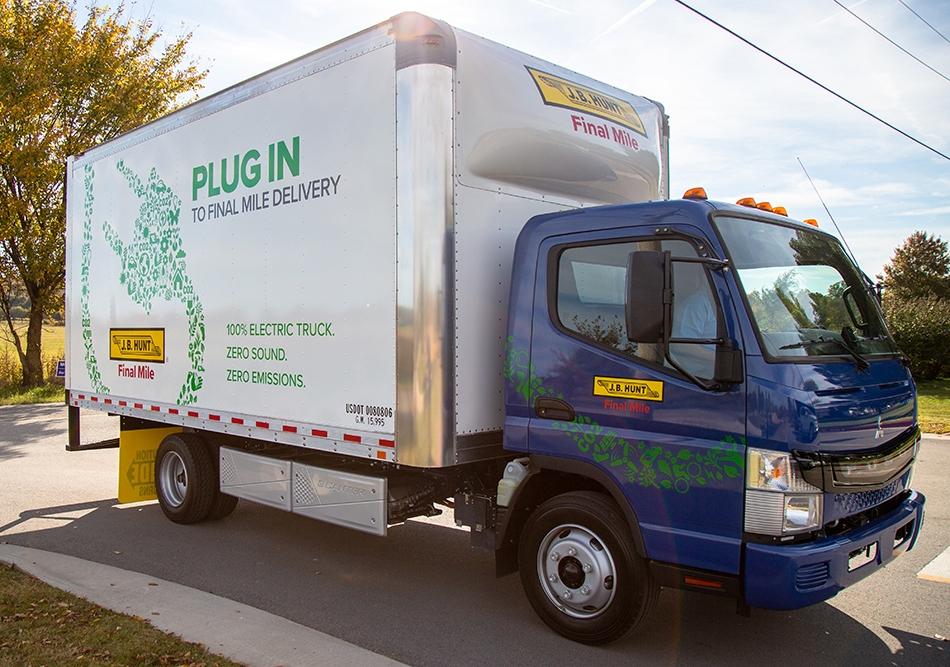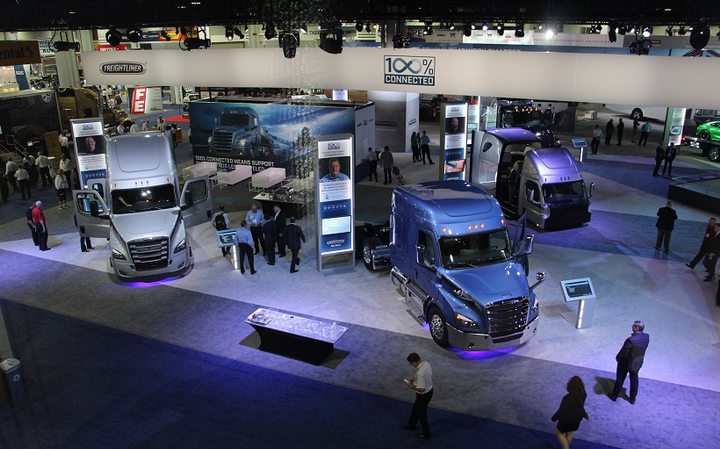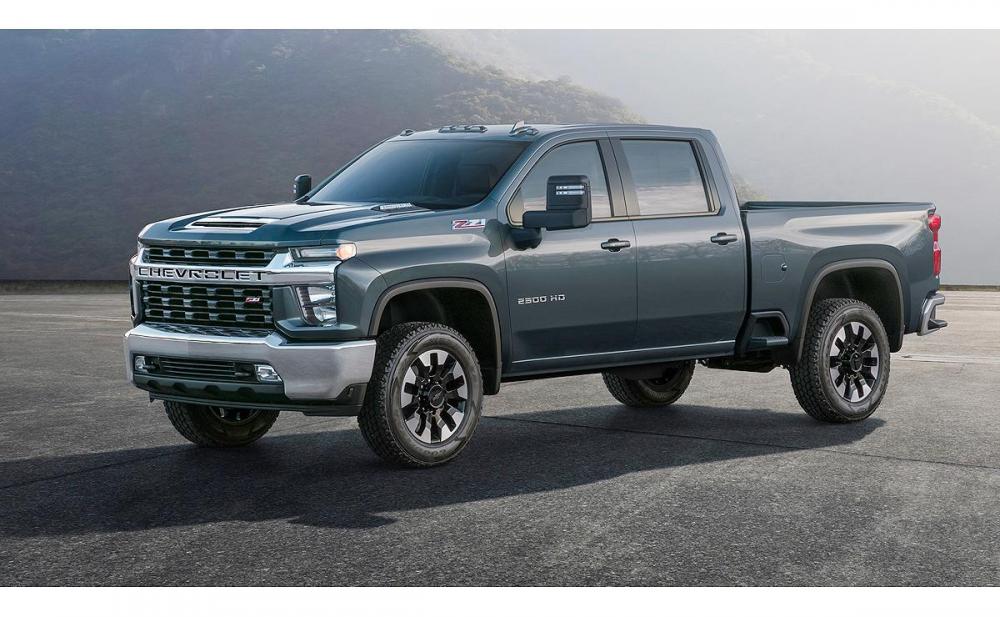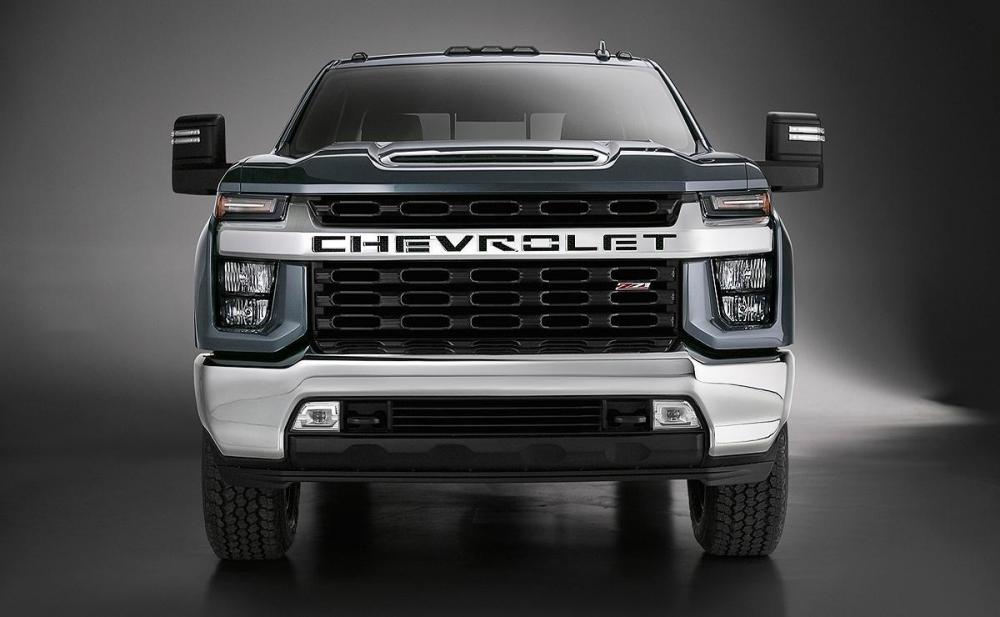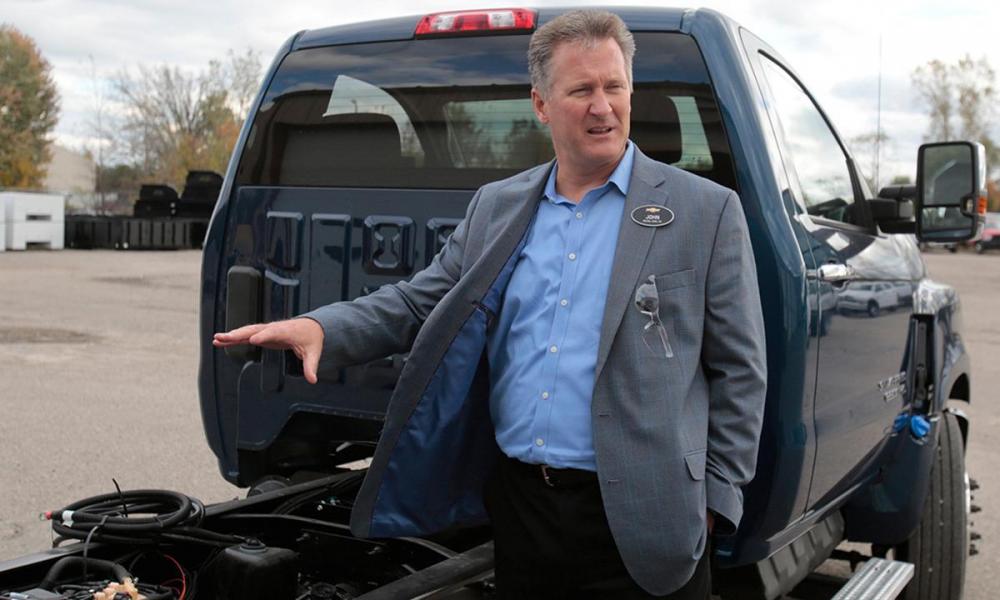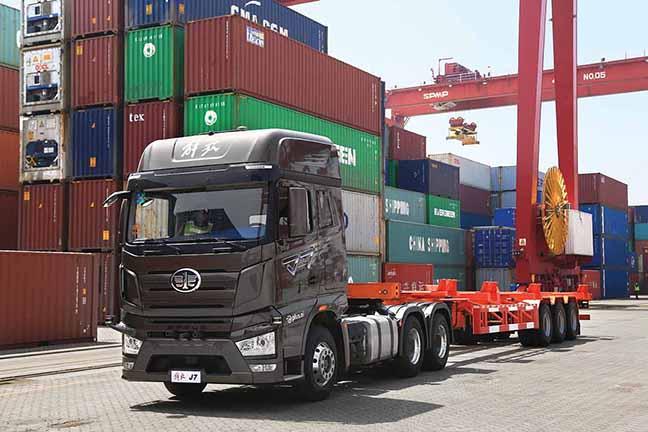
kscarbel2
Moderator-
Posts
18,855 -
Joined
-
Days Won
114
Content Type
Profiles
Forums
Gallery
Events
Blogs
BMT Wiki
Collections
Store
Everything posted by kscarbel2
-
.
-
Cummins Press Release / December 5, 2018
-
Daimler launches Mitsubishi Fuso eCanter in US market
kscarbel2 replied to kscarbel2's topic in Trucking News
J.B. Hunt Transport Services Takes Delivery of First All-Electric Trucks Transport Topics / December 5, 2018 J.B. Hunt Transport Services has made its first purchase of electric-powered trucks, acquiring five medium-duty eCanter box trucks from Mitsubishi Fuso Truck and Bus Corp. for use in making deliveries in Santa Fe Springs, Calif., and in the greater Houston area in Texas. The purchase was announced in an ceremony at J.B. Hunt headquarters in Lowell, Ark., on Dec. 5. “These trucks may be silent, but they speak loudly of our dedication to creating a more sustainable transportation system,” J.B. Hunt CEO John Roberts said in a statement. “Our efforts to reduce our carbon footprint and improve efficiency stretch across the supply chain, from intermodal load conversion to enhancing the aerodynamics and safety of our fleet. This latest addition brings that effort to the last mile and directly to the consumer’s doorstep.” J.B. Hunt is the second national carrier to introduce the eCanter trucks in the United States since the vehicle was launched in New York City in October 2017, according to Mitsubishi Fuso officials. Justin Palmer, president and CEO of Mitsubishi Fuso Truck of America, which is based in Logan Township, N.J., said the sale to J.B. Hunt represents an industry milestone. “The eCanter demonstrates that the future of electric trucks is very possible and is no longer a prototype, but a real truck delivering real goods daily,” he stated. The first fleets to take delivery of the eCanter were Japanese grocery retailer 7-Eleven and Yamato Transport. U.S. customers include parcel carrier UPS Inc., the University of California and the New York Botanical Garden. The trucks, which are produced at plants in Kawasaki, Japan, and Tramagal, Portugal, are powered by six high-voltage lithium-ion batteries with a driving range of 80 miles on a full charge and a maximum payload of about 9,380 pounds. The electric trucks will be added to the Final Mile Services division of J.B. Hunt Dedicated Contract Services unit. J.B. Hunt DCS ranks No. 1 on the Transport Topics list of largest dedicated contract carriers in North America with 8,727 power units. Overall, J.B. Hunt operates a fleet of more than 15,600 tractors and 734 straight trucks, according to registration data on file with the U.S. Department of Transportation. -
2020 Silverado HD Equipped with Allison Transmission Heavy Duty Trucking (HDT) / December 5, 2018 Chevrolet will offer a 10-speed, fully automatic Allison transmission in its 2020 Silverado 2500/3500 HD trucks. The 2020 Silverado HD will debut in February. “We built the new 2020 Silverado HD with more differentiation than ever before, to meet the needs and priorities of our customers,” said Jaclyn McQuaid, chief engineer, Silverado HD. “By offering the new Allison 10-speed, tested and validated in partnership with Allison Transmission, each transmission will deliver the legendary quality and durability that customers have come to expect. The Allison-branded automatic transmission, manufactured by General Motors, combines enhanced performance and fuel economy, greater operational flexibility, and improved driver comfort and control, with an industry-leading reputation for uptime and reliability, according to the companies. The Allison 10-speed transmission will be coupled with Chevrolet's Duramax diesel engine. "We are pleased that General Motors continues to expand the range of Allison products available for their customers with the 2020 Silverado HD," said Randy Kirk, senior vice president of product engineering and program management for Allison Transmission. "Allison Transmission and GM have a long history of collaboration and innovation." Recently, Allison began producing the 6-speed fully automatic transmission for Chevrolet’s Silverado 4500 HD, 5500 HD, and 6500 HD medium-duty trucks.
-
Heavy Duty Trucking (HDT) / December 4, 2018 Reyco Granning has announced the launch of the Reyco Granning Electric Vehicle Solutions business unit, aimed at serving the burgeoning electric vehicle market. The unit aims to solidify the company’s commitment to the future of heavy duty vehicle propulsion and emphasize current solutions for today’s electric vehicle market. “We want the industry to know that we already have solutions that are compatible with e-axles and available today for the heavy EV space,” said John Stuart, Reyco Granning president. “We’re not just peddling CAD renderings and concepts.” The company recently launched a new air suspension supply and control module called AirMaster. The product utilizes an electronic air compressor and proprietary programming to dramatically reduce parasitic power consumption suitable for the EV market or for any vehicle without an engine-mounted compressor. “We don’t have an automotive division to distract us; we don’t sell bumpers or fifth-wheel couplings. We are a pure suspension technology company.” said Scott Ames, business development. Reyco Granning’s IFS product range includes applications for GAWR's from 9,000 to 24,000 pounds and in mid-2019 the company will launch the ComfortMaster IFS with a Nitrogen-strut architecture.
-
Heavy Duty Trucking (HDT) / December 4, 2018 Launching in 2017, the second North American Commercial Vehicle Show promises to include all major Class 8 truck manufacturers for the 2019 show, including Peterbilt and Kenworth for the first time. Freightliner, Western Star, Volvo Trucks, Mack Trucks, Navistar, and Hino all will return, again displaying and launching new products on the NACV show floor. The second NACV show is set for Oct. 28-31, 2019 at the Georgia World Congress Center in Atlanta, Ga. The upcoming show is growing and will cover 530,000 square feet of exhibition space, up from 370,000 square feet, and is expanding into a second building. Organizers expect to host more than 500 exhibitors, up from 439 in 2017. Over 15,000 fleet management attendees are expected to visit the show in 2019, more than double the number of attendees at the inaugural event. In addition to truck makers, NACV will also host leading trailer manufacturers and top tier suppliers, including Bendix, BorgWarner, Bosch, ConMet, Continental, Cooper Tire, Cummins Inc., Dana, Dorsey Trailer, Great Dane, Hendrickson, Holland, Hyundai Translead, Meritor, SAF Holland, Tenneco, Thermo King, Utility Trailer Manufacturing, Wabash, and Wabco. The show will offer exclusive looks at the latest model power units and trailers, advanced driver assistance systems, fuel efficiency equipment, safety technologies and electronic logging devices. For 2019, it will also include a broader array of maintenance services, high-quality truck accessories, and driver retention and recruiting services. “Since its 2017 launch in Atlanta, the NACV Show continues to impress the industry with its cutting-edge demonstrations of commercial vehicle innovations and technologies,” said Larry Turner, president and CEO of Hannover Fairs USA, NACV’s co-organizer with partner Newcom Media. “We are excited to expand the event’s footprint and offerings next year, and to continue to focus on the needs of a larger audience of fleet owners, fleet managers, fleet maintenance managers and other key decision makers from across North America.” .
-
Heavy Duty Trucking (HDT) / December 3, 2018 As Class 8 truck production is booming in 2018, the numbers show a trend toward smaller-displacement engines and more straight trucks. Medium-duty has seen a similar trend. Overall Class 8 truck production is expected to continue its growth trend into 2019, but changes in demand for straight trucks and tractors will affect the type of diesel engines being ordered. This trend is so strong that Class 8 trucks with 12.0L to 14.0L engines are expected to surpass the 14.0L category for the first time ever in 2019. While tractors still represent 73% of all Class 8 production in 2018, the straight truck segment is expected to grow to a 32% share in the future. There is a similar movement in the medium-duty Class 5 through Class 7 truck market, where gasoline engines are gaining adoption. In the Class 5 segment, V-8 and V-10 gasoline engines are increasing in popularity. In the larger Class 6 through Class 7 markets, six-cylinder diesel engines remain the preferred configuration. The report also predicts increased adoption of alternative-fuel vehicles, driven by tighter emissions regulations. “Diesel power is under attack long-term for use in on-highway commercial vehicles. Alternative power is being developed, tested, and refined, while diesel engines are also undergoing transition to become more fuel-efficient and clean,” said one analyst. “It is vital for industry participants to stay up-to-date on developments like the recent EPA update to the NOx emission standards for heavy-duty engines and funding awarded under the Diesel Emission Reduction Act.”
-
Ford CEO discounts job-cut report, promises more news this week Keith Naughton, Bloomberg / December 5, 2018 DETROIT — Ford Motor Co.'s CEO downplayed a report that the automaker may cut 25,000 jobs and said he'll have more news to share later this week. CEO Jim Hackett told reporters Tuesday that Ford didn't provide numbers to Morgan Stanley analyst Adam Jonas, who estimated the significant employee reduction in a report a day earlier. Ford said in July it would spend three to five years on an $11 billion restructuring. Ford will make an interim announcement about plans for its workforce later this week, Hackett told reporters in Michigan. General Motors announced last week it will cut more than 14,000 employees and close seven factories worldwide by the end of next year.
-
Mack “C Series” fire apparatus, simply the most attractive of all time.
-
GM moves to challenge Ford in U.S. commercial fleet sales
kscarbel2 replied to kscarbel2's topic in Trucking News
The one negative about the Class 6 Silverado/CV is it looks like a “baby Class 6” when parked next to a DuraStar or Freightliner M2 106. It really only competes with the F-650. Like the F-650, lacking a Cummins ISB option, many fleets will pass and continue to buy DuraStars (MV) or M2s. -
GM moves to challenge Ford in U.S. commercial fleet sales
kscarbel2 replied to kscarbel2's topic in Trucking News
I hear you. But surprisingly GM has some legitimate truck people. Navistar head Troy Clarke is GM alumni.....I know him personally.....he’s sharp as a tack. The GM-Navistar cooperation will proceed blossom, and expand. It’s a great win-win that eliminates duplication of effort, resulting in great savings. Does Ford really do it all in-house? The PowerStroke was not designed by Ford. Ford outsourced it to AVL in Austria. -
If Volvo has good sense Paul, they’d make you head of Mack brand sales marketing. You have the gift.
-
GM moves to challenge Ford in U.S. commercial fleet sales
kscarbel2 replied to kscarbel2's topic in Trucking News
The Vauxhall Movano and Vivaro could have been brought over before Transit and Promaster. https://www.bigmacktrucks.com/topic/47523-vw-considers-crafter-commercial-van-for-us/?tab=comments#comment-350895 -
VW says it might use Ford manufacturing capacity in U.S. Automotive News & Bloomberg / December 4, 2018 WASHINGTON -- Volkswagen's CEO said on Tuesday after a meeting at the White House that the German automaker was building an alliance with Ford and that they might use the U.S. automaker's plants to build cars. VW CEO Herbert Diess said the company was also "considering building a second car plant," adding, "We are in quite advanced negotiations and dialog with Ford to really build up a global automotive alliance, which also would strengthen the American automotive industry." Ford and VW said on June 19 they would explore a strategic alliance and they agreed to a memorandum of understanding at the time. Talks further intensified this fall, the automakers said in October. Bill Ford, executive chairman of Ford, on Tuesday said: “We haven’t gotten that granular in our talks yet, but clearly we are talking with them.” He said the talks were going “really well” and that “the culture fit is good.” The automakers have said previously they are talking about potential collaborations across a number of areas. VW has an assembly plant in Chattanooga, Tenn. Of the need for a new plant, Diess said the company is in "quite advanced negotiations in Tennessee but there might be other options as well." Diess said VW would not take an equity stake in Ford as part of its alliance. "We are building an alliance with Ford which will strengthen Ford's position in Europe because we will share platforms," he said. "We might use Ford capacity here in the U.S. to build cars for us." Diess said VW planned to talk more about the Ford alliance in January. “We need additional capacity here in the United States, we need an additional car plant for VW and Audi combined,” Diess told reporters in Washington after meeting with President Donald Trump and trade officials. Ford and VW have been in talks for more than a year about the German automaker investing in Argo AI, the American automaker’s self-driving technology partner, to jointly develop autonomous cars, according to people familiar with the discussions. The two automakers also are considering tie-ups to produce electric vehicles and share manufacturing in regions around the world, the people have said. “We’re having a very broad set of discussions about how we can help each other around the world,” Bob Shanks, Ford’s CFO, said in an October interview. “Collaboration isn’t being limited in any way whatsoever.” Diess also said VW is in advanced negotiations in Tennessee, where the company already has a plant, about boosting its U.S. capacity, but that there could be other options. A decision could be made in early 2019, he said. Any agreement for VW to use Ford plants for production would presumably require negotiations with the UAW, which has been trying unsuccessfully to organize VW's plant in Chattanooga. UAW Ford Vice President Rory Gamble, through a spokesman, told Automotive News he would reserve comment on this issue "until he has formal discussions with Ford." Diess was joined at the meeting by his counterpart at Daimler AG, Dieter Zetsche, and BMW Chief Financial Officer Nicolas Peter. The carmakers have found themselves in harm’s way as Trump wields higher tariffs as a cudgel to rebalance trade with both China and the European Union. BMW and Daimler are the biggest car exporters from the U.S. to China, while VW’s two most profitable brands, Porsche and Audi, would get hammered if Trump follows through with a potential 25 percent levy on imports from the EU. “That’s basically why we are here, to avoid the additional tariffs and I think we’re in a good way,” Diess said. The three carmakers have no official role in the overall trade talks between U.S. and EU trade officials, and stressed that at the end of their meetings. The companies are trying to avoid becoming entangled in the talks but they accepted the invitation extended by a Trump administration eager to jump-start progress on its highest priorities. “We weren’t here as a trade delegation,” Zetsche said. “We said in general terms that our planned additional investments here that are not commercially sensible per se of course would have to be part of a larger understanding and for that the conditions under which we operate cannot change. That was very well understood,” Zetsche said. Trade deficit The White House is looking to whittle down a $30 billion automotive trade deficit with Germany with increased production in the U.S., Commerce Secretary Wilbur Ross said ahead of a meeting with automakers in Washington Tuesday. It remains the biggest single chunk of an overall $65 billion trade deficit with the EU. All three carmakers met separately with Trump’s key lieutenants on trade, including Ross, U.S. Trade Representative Robert Lighthizer and economic adviser Larry Kudlow, before a joint meeting that followed. They then met with Trump in the Oval Office. “The president shared his vision of all automakers producing in the United States and creating a more friendly business environment,” Lindsay Walters, a White House spokeswoman, said. Daimler, the maker of Mercedes-Benz luxury cars produces vehicles in Tuscaloosa, Ala., shipping many of its SUVs made there to China. Daimler employs some 3,700 workers at the U.S. site, which can churn out more than 280,000 vehicles per year, including GLE and GLS SUVs for global markets and C-class sedans for North America.
-
2020 Chevy Silverado HD diverges from smaller sibling Michael Wayland, Automotive News / December 4, 2018 General Motors is further differentiating the 2020 Chevrolet Silverado HD from its smaller sibling. The redesigned HD pickup's grille features a flow-through "CHEVROLET" similar to some models of the Silverado 1500, but the HD's grille is much larger than the Silverado 1500's and is flanked by headlight stacks with a chrome bar separating a top light from two lower lights. It also has a large air intake above the grille and is noticeably larger than the Silverado 1500. The only exterior piece the Silverado HD shares with its smaller sibling is the roof, according to GM. Company officials said the greater differentiation resulted from feedback from owners, who said they wanted their HD models to stand out from the Silverado 1500 models. "We set out to make a statement with the 2020 Silverado HD and wanted to visually capture the power and capability of the truck," said Brian Izard, Silverado HD lead exterior designer, in a statement. "The result is a truck that looks like a piece of heavy machinery with modern, chiseled finishes and customer-focused details." The automaker released photos and some information about the Silverado HD Tuesday before its official debut in February. The redesigned Silverado HD will be offered with a new gasoline engine with direct injection mated to a six-speed transmission, or the Duramax turbodiesel V-8, rated at 910 pound-feet of torque, with a new Allison 10-speed transmission. The company said the Silverado HD will have "all-new customer-focused trailering technology" and "significant increases in towing and payload capabilities," but it did not release performance metrics. The 2020 Silverado HD -- produced in Flint, Mich. -- is expected to go on sale in mid-2019. It will be the third new or redesigned Silverado in the last 18 months, following the redesigned 1500 and new medium-duty. .
-
Reuters / December 4, 2018 U.S. President Donald Trump on Tuesday held out the possibility of an extension of the 90-day trade truce with China but made clear he would revert to tariffs if the two sides could not resolve their differences. Trump said his team of trade advisers led by China trade hawk U.S. Trade Representative Robert Lighthizer will determine whether a “REAL deal” with China was possible. “If it is, we will get it done,” Trump said in a Twitter post. “But if not remember, I am a Tariff Man.” The Republican president indicated he would not be opposed to extending the 90-day truce he and Chinese President Xi Jinping agreed on over the weekend. “The negotiations with China have already started. Unless extended, they will end 90 days from the date of our wonderful and very warm dinner with President Xi in Argentina,” Trump said on Twitter. Trump and Xi on Saturday agreed to the ceasefire in a trade war that has seen the flow of hundreds of billions of dollars worth of goods between the world’s two largest economies disrupted by tariffs. The two leaders said they would hold off on imposing additional tariffs for 90 days starting on Dec. 1 while they seek a solution to their trade disputes. Trump has said China is supposed to start buying agricultural products immediately and cut its 40 percent tariffs on U.S. car imports. White House economic adviser Larry Kudlow said on Tuesday that a reduction in Chinese tariffs on U.S. cars and agricultural and energy commodities would be a “litmus test” for whether U.S.-China trade talks are on track to succeed. The United States also expects China to promptly address structural issues including intellectual property theft and forced technology transfers, U.S. officials have said. “So, again this will be a real agreement again and not that we can accomplish everything in 90 days but we expect to make a lot of progress and President Trump will be directly involved,” Treasury Secretary Steven Mnuchin told Fox Business Network on Tuesday. Trump has long accused China of unfair trade practices that hurt Americans and the U.S. economy. “When people or countries come in to raid the great wealth of our Nation, I want them to pay for the privilege of doing so. It will always be the best way to max out our economic power,” he said on Tuesday. His appointment of Lighthizer to lead the talks instead of Treasury Secretary Steven Mnuchin puts one of the administration’s toughest China critics in charge. Trump said on Tuesday that Lighthizer would work closely with Mnuchin, Kudlow and trade adviser Peter Navarro.
-
Nick Carey, Reuters / December 4, 2018 FLINT, Mich. — General Motors is intensifying its attack on rival Ford's lead in sales to U.S. commercial fleets to prop up profit margins amid weakening consumer demand, according to executives at the No. 1 U.S. automaker. GM is counting on new medium-duty Silverados — outfitted as tow trucks, utility bucket trucks and delivery trucks — to lift demand for its light-duty trucks and cars. Automakers estimate for every medium-duty truck a corporate customer buys, they purchase up to six pickups, SUV, crossovers or cars. The need for automakers to bolster U.S. sales and keep plants humming was highlighted last week when GM slated five North American factories for potential closure, including two making the type of sedan that has fallen out of favor with American consumers. Ford announced it would shuffle workers from slower to busier plants. Most major automakers on Monday also reported lower U.S. November sales. But a 24 percent jump in commercial fleet sales in November vs. the same month in 2017 helped GM offset a 1 percent retail sales drop, according to a source briefed on figures GM does not make public on a monthly basis. GM North America chief Alan Batey says the automaker has pursued a long-term strategy to cut lower-margin rental fleet sales and boost more lucrative commercial sales. GM's rental sales are around 10 percent of total sales this year, down from 15.8 percent in 2013. In the same period, GM's commercial sales have risen to more than 11 percent from 7.8 percent of sales. Batey said production of GM's medium-duty trucks, which begins this week under a partnership with truck maker Navistar International Corp. as an extension of the Chevrolet Silverado pickup line, is a milestone in the automaker's move to increase market share. GM exited the segment during its bankruptcy in 2009. It originally announced the planned Navistar venture in September 2015. GM and Ford compete for business from companies like engineering-services firm U.S. Infrastructure Co., which has around 9,000 vehicles, mostly light-duty Chevrolet Colorado pickup trucks. USIC's workers mark cable lines, water pipes and other underground infrastructure before contractors start digging holes in the ground. USIC fleet manager Phil Samuelson said in a recent interview the company needs around 20 medium-duty trucks, fast. GM won his order by promising to accelerate production of his trucks. Otherwise, Samuelson would have tried Ford or Fiat Chrysler Automobiles. "We have a great relationship with GM and we saw no reason not to continue that," he said. Satisfying customers like USIC could help GM next year when Ford launches its Ranger pickup, a direct competitor for the Colorado. Rising commercial fleet sales have lifted GM's net profit by $1 billion over the last five years, according to sources familiar with GM's financials. Tax overhaul boost Commercial fleet sales are increasingly important as consumer vehicle sales are set to weaken over the next couple of years after an eight-year recovery. Ford, GM and FCA control around 77 percent of commercial fleet sales for Classes 1 through 6 — from cars to the biggest medium-duty trucks — though Ford dominates at 40 percent, according to data compiled by Cox Automotive for Reuters from nonpublic sources. GM has around 25 percent market share. Ford executives say they have no special plans to counter GM's expanded truck portfolio. "We're just going to do what we always do," said John Ruppert, Ford's general manager for commercial vehicle sales. Through November, GM's commercial fleet sales rose 14 percent compared with a 5 percent increase at Ford. U.S. auto retail sales are forecast to fall over the next two years. But commercial fleet sales should rise, partly because of tax write-offs in the 2017 U.S. federal tax overhaul. Desperate need GM's decision to re-enter the medium-duty truck segment was driven by commercial customers that seek several types of vehicle in package deals. "If I want a medium-duty truck I end up going to Ford and the chances are I'll also buy my pickup truck from Ford instead of GM," said one market analyst. "Dealers desperately need these trucks to go after industries we haven't been able to go to with existing product," said John Schwegman, GM's commercial product director. Keith McCluskey, owner of McCluskey Chevrolet in Cincinnati, Ohio, said his commercial fleets now account for 10 percent of his sales, down from 40 percent when he last sold GM medium-duty trucks. McCluskey has built a new $8 million service facility partly for commercial customers and aims to sell 1,000 medium-duty trucks annually. .
-
Call Mack brand customer service at +1 (866) 298-6586 and tell them your dealer is unable and/or unwilling to assist you. BTW, what year is it?
-
CHANGCHUN, Dec. 4 (Xinhua) -- FAW Group's commercial truck subsidiary sold a record 299,273 light, medium and heavy trucks in the first 11 months of 2018, the company said Tuesday. The company has introduced several new models into the market this year, including the all-new European level J7 heavy tractor. The company set a goal to sell 350,000 vehicles in 2020 and 430,000 vehicles in 2023. The number is expected to hit 500,000 in 2025. Founded in 1953, FAW Group is known as the cradle of China's auto industry. Since the first model CA10 FAW truck rolled off the line in 1956, the brand has sold more than 6.6 million vehicles and has expanded its presence to 80 countries around the world. .
-
Cerberus to Acquire Majority Interest in Navistar Defense
kscarbel2 replied to kscarbel2's topic in Trucking News
Stephen Feinberg, the Private Military Contractor Who Has Trump’s Ear Stephen Witt, The New Yorker / July 13, 2017 In the last week of the 2016 Presidential campaign, Stephen Feinberg, the billionaire Manhattan financier, made the largest political donation of his life. On November 3rd, just five days before the election, he gave nearly a million dollars to Rebuild America Now, the Trump-supporting super PAC known for its blistering attacks on Hillary Clinton. That Sunday, the PAC spent eight hundred thousand dollars on an eleventh-hour blitz of negative TV spots, including one that aired repeatedly during N.F.L. broadcasts, condemning Clinton’s support for changing the name of the Washington Redskins. “Yeah, you thought you were safe, sitting in your recliner in your man cave, cold beer and a bowl of chips,” the ad said. “Wrong. Hillary Clinton wants to mess up your football, too.” Two days later, Trump won the Presidency. Feinberg is lean, with a runner’s physique and a mild New York accent. His manner is equanimous, and his focus on the task at hand is intense. All who have worked with him speak of his penetrating analytic intelligence, his surpassing desire for privacy, and his steady hand as an investor. To the financial press, he is known as the C.E.O. of Cerberus Capital Management, one of the country’s largest investment firms, with business lines in private equity, distressed debt, hedge funds, and real estate. His holdings have included the once struggling General Motors automotive-financing division, the controversial defense contractor DynCorp, and the Bushmaster assault-rifle brand. For Feinberg, the Trump campaign was a classic investment target: compromised, flailing, politically toxic—but ultimately successful. This February, it was reported that Feinberg was being considered for a post in the Trump Administration, overseeing a shakeup of the United States intelligence community. Career spies were alarmed at the suggestion; Feinberg has no intelligence experience, and his history at Cerberus suggested the likelihood of a radical restructuring, starting with management. This skepticism of his suitability for the role was shared by a former Cerberus insider with whom I spoke. “He’s a phenomenal manager of an investment fund, but his brilliance is in his trading,” he said. “I don’t think he’d succeed in the bureaucratic environment of Washington.” (Through a spokesperson, Feinberg declined to comment.) The Trump Administration did not go forward with the appointment, but the rumors have persisted. And, this week, the Times reported that Steve Bannon and Jared Kushner had reached out to Feinberg—as well as to Erik Prince, the founder of Blackwater—for private-sector alternatives to the Department of Defense’s plan to send more troops to Afghanistan. Through DynCorp, Feinberg already controls one of the largest military contractors in the U.S., one which trains Afghanistan’s police force and assists in their narcotics-trafficking countermeasures. According to the Times, Feinberg proposed an expanded role for such contractors, and also recommended transferring the command of paramilitary operations in the country to the C.I.A., increasing their operating footprint while decreasing both transparency and accountability. He reportedly discussed Afghanistan with President Trump in person. The proposals raise obvious questions about war profiteering and conflicts of interest. DynCorp has been a bad investment for Feinberg. Buying at the tail end of the military-contracting boom of the two-thousands, Cerberus overpaid for the company, then watched as much of its business evaporated following government-spending cuts and the drawdown of U.S. troops in in Iraq and Afghanistan. In the seven years since Cerberus acquired the company, Feinberg has replaced DynCorp’s C.E.O. four times. Afghanistan, in particular, has been a problem. In recent years, the country has proved no more hospitable to for-profit military contractors than it has to stumbling empires. DynCorp’s profit margins are thin there; revenues are falling, according to the former Cerberus insider. Several high-level managers from Cerberus portfolio companies have defected to Pacific Architects & Engineers, an upstart competitor that is taking DynCorp’s business. And DynCorp workers are often in peril. Since Cerberus acquired the company, twenty-nine DynCorp employees have been killed on the job. Most of them died in Afghanistan, including a retired U.S. Army colonel whose convoy was hit by a bomb. A suggestion from Feinberg to expand the role of military contractors would be naked in its self-interest, but his other recommendation—transferring paramilitary operations in Afghanistan to the C.I.A.—deserves equal scrutiny. Here, Feinberg is operating from the heart. Although his personal military experience is limited to a brief stint in the Princeton R.O.T.C., he has, through his investments, developed an unusually close relationship with the U.S. Special Forces community. Of particular interest is Tier 1 Group, a Cerberus-owned private military base outside Memphis, which has, since 2008, served as a training ground for Navy SEALs and Marine Special Operations. Tier 1 Group’s facilities include a long-distance-shooting range, an ersatz Afghan village for staging commando raids, and an outdoor road course for tactical-driving training. Through his control of the facility, Feinberg has even been provided with after-action reports from Special Operations missions, according to Steve Reichert, the founder of Tier 1, who spoke to me for a story I wrote for New York magazine. (Feinberg has also received training from military instructors, and is said to be a crack shot.) Whatever their merit, Feinberg’s recommendations to the Trump camp were pushed aside, according to the Times, by Defense Secretary James Mattis, a career military man. But given Trump’s openness to outside counsel—and, in particular, his interest in the ideas of other billionaires—it’s possible that Feinberg’s ideas could resurface. Conflicts of interest notwithstanding, Trump could do worse in selecting an adviser. Indeed, he has done worse: Feinberg’s formidable intellect and concrete managerial experience are more valuable assets than Jared Kushner’s prep-school-and-real-estate background or Steve Bannon’s theories of pseudo-history. For now, Feinberg remains a peripheral figure in the Trump Administration, but sooner or later, one suspects, he’ll see a return on his investment. -------------------------------------------------------------------------------------------------------------------------------------------- Trump Chooses Cerberus’s Stephen Feinberg to Lead Spy Advisory Panel Jennifer Epstein, Bloomberg / May 11, 2018 President Donald Trump has chosen billionaire investor Stephen Feinberg to lead his intelligence advisory board, the White House said Friday. Trump intends to appoint Feinberg, the co-founder and co-chief executive officer of Cerberus Capital Management in New York, to chair the President’s Intelligence Advisory Board, which plays a role in overseeing the intelligence community, deriving its influence from direct access to the president and his senior staff. Among Cerberus’ holdings is the military contractor DynCorp International, which receives the vast majority of its $3 billion in annual revenues from the federal government. The New York Times reported last July that Steve Bannon, then the White House chief strategist, and Jared Kushner, the president’s son-in-law and adviser, had asked Feinberg, as well as Blackwater founder Erik Prince, for proposals to send private-sector workers to Afghanistan in place of American troops. In March 2017, Feinberg joined Trump and Defense Secretary Jim Mattis on a trip to see the new aircraft carrier Gerald R. Ford in Newport News, Virginia, after it was reported that Feinberg had held discussions with the administration about a review of U.S. intelligence agencies. Some critics at the time assailed Feinberg as ill-equipped for the role. At a Senate hearing that month, Republican Senator Susan Collins of Maine expressed concern that "an individual who runs a private equity firm" and doesn’t have experience in the relevant areas was being considered for the job. The White House suggested in a statement Friday that Feinberg was well-suited for the position because of his "over 30 years of experience conducting organizational assessments, operational improvements, and complex reforms across foreign and domestic stakeholders to his position." -
“They [China] put on the table an offer of over $1.2 trillion in additional [trade] commitments. But the details of that still need to be negotiated. This is the first time that we have a commitment from them that this will be a real agreement.” Treasury Secretary Steve Mnuchin -------------------------------------------------------------------- “The history here with China promises is not very good. And we know that. However, I will say this: President Xi has never been this involved. They cannot slow walk this, stall this, meander this. Their word: ‘immediately.’” National Economic Council Director Larry Kudlow
-
Cerberus to Acquire Majority Interest in Navistar Defense
kscarbel2 replied to kscarbel2's topic in Trucking News
Am I missing something? Steve Feinberg-managed Cerberus Capital Management is an American private equity firm based in New York. Now I don't know what Feinberg and Troy Clarke worked out, but one possibility is...........there is a shared desire to take on Oshkosh. However, NAV doesn't have the finances to do it, and a VW buyout is NOT on the horizon. Enter Cerberus, who sees a profit opportunity. And by having Cerberus fund 70 percent of the extremely cyclical defense business, Troy Clarke will have more funds to invest in commercial truck product development. The in-depth update of all the models, and the new Silverado-based CV, is a brilliant success. But by 2022, NAV will need all-new replacements in order to be competitive.
BigMackTrucks.com
BigMackTrucks.com is a support forum for antique, classic and modern Mack Trucks! The forum is owned and maintained by Watt's Truck Center, Inc. an independent, full service Mack dealer. The forums are not affiliated with Mack Trucks, Inc.
Our Vendors and Advertisers
Thank you for your support!



